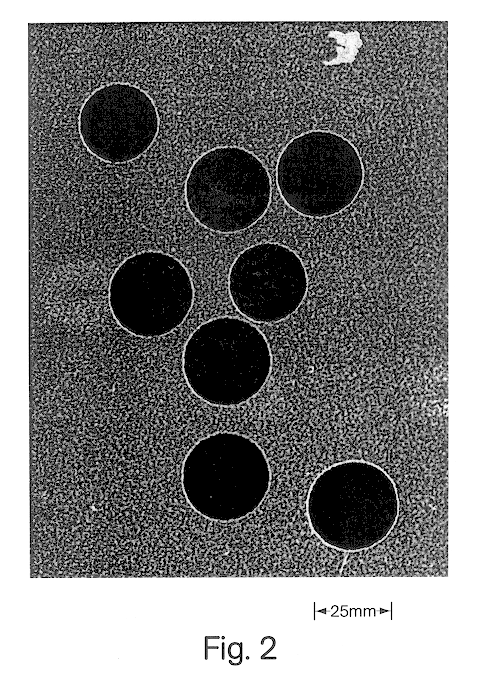Synthesis of nanometer-sized particles by reverse micelle mediated techniques
a reverse micelle and nanometer technology, applied in the direction of catalyst activation/preparation, metal/metal-oxide/metal-hydroxide catalyst, chemical/physical process, etc., can solve the problems of loss of dispersity and desired morphology, difficulty in controlling particle morphology, and typical prior art materials that undergo unacceptable vaporization, sintering, or other degradation, so as to increase the overall surfactant concentration and reduce the overall ratio of cosurfactant to
- Summary
- Abstract
- Description
- Claims
- Application Information
AI Technical Summary
Benefits of technology
Problems solved by technology
Method used
Image
Examples
example 2
Preparation of the Mixed Ba-Al Alkoxide Solution.
2-Propanol (Malinckrodt Chem. Co., 99+% pure) was degassed and dried by argon (BOC Gases, Grade 5.0) exchange. 1 g of metallic barium (Aldrich Chem. Co. Inc., 99+% pure) was mechanically milled and placed in a 1000 ml dried flask. As an alternative to mechanical milling, the barium can be reacted as a pellet, ingot, wire or the like. 250 ml of dried 2-propanol was transferred to the flask under argon and refluxed at 110.degree. C. for 24 h. 9.6 g of aluminum isopropoxide (Aldrich Chem. Co. Inc., 98+% pure) were added to the barium isopropoxide solution and refluxed for 24 additional hours. The combined barium / aluminum precursor concentration was 5.42 wt %. No solid residues were observed after refluxing. Some of the resulting precursors solutions were further dissolved in dried 2-propanol in 1:2 and 1:4 ratios, yielding final precursors concentrations of 2.71 wt % and 1.35 wt % respectively.
We found that concentration of the precursor...
example 3
Hydrolysis and Aging of the Alkoxide Precursors
The alkoxide solutions were added to the nanoemulsions at different rates, from 0.1 to 10 ml / min, and under various temperatures, from 25 to 80.degree. C. The resulting gels were aged for different time lengths at a range of temperature and agitation conditions.
Effect of Water Content and pH in the Hydrolyzing Emulsion. The water content was found to affect the degree of agglomeration and the yield of materials per gram of emulsion. The high and medium water concentrations were found to give less agglomeration of the hydrolyzed materials and a more uniform particle size than the low-end values. FIG. 5 shows a plot of the particle size distribution as observed in TEM for different water contents. After aging for 8 h at room temperature, low water concentrations, below 5 wt %, were observed to yield agglomerated particles of 100-150 nm in diameter. When the water content in the emulsion was raised to 5 to 20 wt %, particles of 50-100 nm w...
example 4
Particle Recovery
The hydrolyzed and aged gels were recovered using two methods. In the first procedure, 2-propanol was added until a macroscopic two-phase separation of the emulsion was observed. The lighter phase contained the hydrocarbon organic phase, the alcohol cosurfactant, and a small amount of the main surfactant and 2-propanol; while the heavier phase contained the hydrolyzed gel, the remaining surfactant, water and 2-propanol. The lighter phase was decanted out. The heavier phase was dried and calcined according to section 2.2.5.
The second recovery method involved freezing the whole system rapidly by spraying it into a liquid nitrogen-cooled flask. The solidified solution was scraped from the flask and placed in a Virtis Co. Cascade Freeze Drier. The organic phase, water, cosurfactant and 2-propanol were selectively sublimed, leaving behind a gel consisting of mainly the surfactant and the hydrolyzed products, with a small content of water and 2-propanol. This gel was then...
PUM
| Property | Measurement | Unit |
|---|---|---|
| particle size | aaaaa | aaaaa |
| water content | aaaaa | aaaaa |
| particle size | aaaaa | aaaaa |
Abstract
Description
Claims
Application Information
 Login to View More
Login to View More - R&D
- Intellectual Property
- Life Sciences
- Materials
- Tech Scout
- Unparalleled Data Quality
- Higher Quality Content
- 60% Fewer Hallucinations
Browse by: Latest US Patents, China's latest patents, Technical Efficacy Thesaurus, Application Domain, Technology Topic, Popular Technical Reports.
© 2025 PatSnap. All rights reserved.Legal|Privacy policy|Modern Slavery Act Transparency Statement|Sitemap|About US| Contact US: help@patsnap.com



